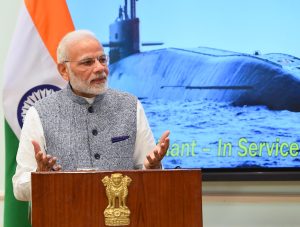Amid worsening ties between India and China, New Delhi is demonstrating seriousness about stepping up its military capabilities, launching its third nuclear missile submarine (SSBN).
The launch was first reported by U.K.-based Jane’s Defence Weekly, based on satellite imagery. Jane’s claimed that India had launched the submarine on November 23.
According to a report by the Hindu, neither the Ministry of Defense nor the Indian Navy confirmed the story but “sources in the navy and Ship Building Centre (SBC) in Visakhapatnam,” where these submarines were built, confirmed the launch of the submarine. A senior naval officer who spoke to the newspaper said that the launch was “nothing more than getting the outer hull floated in water. It was in the dry dock area till now and it is now in the water.”
The submarine still has a long way to go before it is ready for sea trials, then weapon trials and finally commissioning. The first of these SSBNs, the INS Arihant (S2), after which the class is named, was launched in July 2009, with sea trials commencing in December 2014 and commissioning into the Indian Navy taking place in August 2016. The second in the series, S3 or INS Arighat, is in the advanced sea trials phase and is expected to be commissioned soon. The newest submarine is numbered S4 but yet to named.
The Arihant-class submarines are being developed and built indigenously under the Advanced Technology Vessel (ATV) Project at a cost of 900 billion Indian rupees ($12 billion). Well-known defense analysts indicate that the delivery of the four SSBNs will be delayed considerably considering the “difficulties in miniaturising the nuclear reactor and also in creating adequate space for housing the larger K-4 ballistic missiles, in place of the relatively shorter range K-15 missile that the INS Arihant carries.”
Making the submarine arm of India’s nuclear triad credible requires at least four SSBNs. In turn, it also requires placing a sufficient number of nuclear missiles, with sufficient range, on these SSBNs. The first SSBNs, the Arihant and the Arighat, were deficient in this respect as they only carried the relatively short-range K-15 submarine-launched ballistic missiles (SLBMs), though they can reportedly also accommodate four K-4 longer-range missiles. The K-15 has a range of only 750 kilometers, which is insufficient to target China from the Bay of Bengal.
India is also developing the longer-range K-4 SLBM, with a 3,500-kilometer range, a naval version of the Agni-3 intermediate-range ballistic missile (IRBM). The K-4 has undergone a number of tests but it has yet to be deployed. Most recently, the missile was tested from submerged pontoons off the Visakhapatnam coast in January 2020. Though the DRDO did not confirm the test, media reports quoting officials claimed that the launch was successful.
According to an Indian media report citing government sources, the S4 SSBN is “bigger in size, tonnage, and capability compared to S2 and S3.” The S4 will be able to carry eight K-4 or 24 K-15 SLBMs. Jane’s report also detailed the size and tonnage of the submarine.
The naval arm of the nuclear triad is significant for India given its no-first use (NFU) nuclear posture. The naval platform is considered ideal for a nuclear second strike because nuclear-powered submarines, which can stay hidden underwater for prolonged periods, are more survivable than any of the other platforms.
Meanwhile, India’s project to build six nuclear-powered attack submarines (SSNs) has been on the backburner. Former Navy Chief Admiral Karambir Singh made a pitch for it at the Combined Commanders’ Conference in March 2020. The SSNs will cost 960 billion rupees and senior bureaucrats have questioned the need for these boats at a time when the economy is slowing. Nevertheless, the naval chief took the case to Prime Minister Narendra Modi and stressed the need for the 6,000-ton SSNs. According to a media report, the Cabinet Committee on Security (CCS) was ready to approve the project. Nevertheless, even if approved, it is going to be a decade at the least before the first of these submarines will be commissioned.
In the process, India appears to have decided to cancel the proposal for a second indigenous aircraft carrier. It appears unlikely that the project to build a 65,000 tonne IAC-2 indigenous aircraft carrier will be revived anytime soon.
India did operate one SSN, the INS Chakra-2, until recently. This was an Akula-class attack boat, which was on a 10-year lease from Russia, but it went back to Russia 10 months before the expiry of the lease agreement. This was the second nuclear-powered submarine that India leased from Russia. India signed a new agreement in March 2019 to get another SSN on lease from Russia. The Bratsk, an Akula-class nuclear-powered attack submarine, christened as Chakra-3, is currently being refitted in a Russian shipyard as per Indian specifications and requirements. Nevertheless, given the changing security dynamics in the Indian Ocean and beyond, reports suggest that India is exploring the prospects of leasing another SSN from Russia, so that it can have two of the submarines at the same time.
All of these developments are taking place at a time when China’s People’s Liberation Army Navy (PLAN) is building up its muscles. The PLAN has expanded the size of its inventory in significant terms with inclusion of new aircraft carriers, nuclear submarines, and surface ships, and is also expanding its deployments beyond its immediate waters into the Indian Ocean Region. These developments are clearly putting pressure on the Indian navy.

































